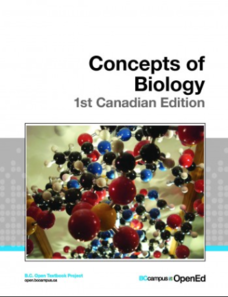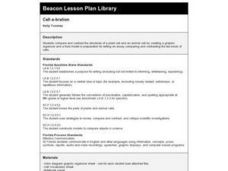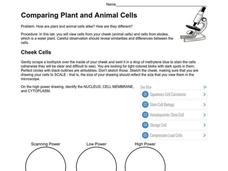Space Awareness
Climate Zones
The climate at the equator is hotter than the climate at the poles, but why? The lesson goes in depth, explaining how the angles of illumination relate to the heating rate at different latitudes and seasons. Scholars use a strong lamp,...
BC Open Textbooks
Concepts of Biology – 1st Canadian Edition
How diverse are living things? Individuals explore topics such as cells as the foundation for life, cell division and genetics, molecular biology, and animal reproduction using an open resource Biology textbook. They learn key terms...
Curated OER
Cell Types
Fourth graders create cartoon characters which compare and contrast two types of cells: nerve and muscle. Cartoon characters show how these two cells are similar, how they are different, and the relationship between the two cell types.
Curated OER
Cell-a-bration
Fifth graders study the structures of a plant cell and animal cell. They create a graphic organizer and a food model. Finally, they write an essay comparing and contrasting plant and animal cells.
Curated OER
Comparing Plant and Animal Cells
In this comparing plant cells and animal cells worksheet, students view cells from their cheeks and cells from elodea. A Venn diagram reveals similarities and differences between the cells.
Curated OER
Cell City
Students understand how various cell parts function and how they are related to the genetic process by creating a model and symbol to depict the function of the cell parts. They research a cell part to determine function and then cut...
Curated OER
Cell Growth and Division
In this biology worksheet, 9th graders identify and explain what cell stay in inter-phase. Then they describe which stage of cell is the shortest and determine why that is true. Students also explain the process of mitosis.
Curated OER
Cell Me What?
Students compare and contrast the characteristics of robots and cells. For this biology lesson, students examine the parts and function of cell organelles. They create a visual representation of their cell/robot analogy.
Curated OER
Cell Reproduction
In this cell reproduction worksheet, students will review the 5 phases of the cell cycle: telophase, interphase, prophase, metaphase, and anaphase. Students will use the cell cycle diagram to complete 5 short answer questions.
Curated OER
Cellular Transport and the Cell Cycle
With a multitude of questions, this worksheet offers learners the opportunity to review their knowledge about the cell cycle. Question types include true/false, word bank, and completing a table about the differences between interphase...
Curated OER
Cell Structure and Function
In this cells worksheet, students review the different types of cells. Students identify the organelles found in an animal cell and determine the function of these organelles. This worksheet has 14 matching, 6 fill in the blank, and 5...
Curated OER
The Incredible, Edible Cell
Students discover organelles and the functions organelles perform in cells. In this biology lesson, students create model cells using Jell-o, then dissect their "cell" to examine the parts that create a cell. Students create a diagram as...
Curated OER
How Cell Phones Work
Fifth graders are introduced to the text, LITERACY LINE viewing the contents page. They review the definition of explanatory writing; discussing the features used and complete a KWL chart to identify what they already know about how a...
Curated OER
Cell Energy Study Guide
In this cell energy instructional activity, high schoolers answer questions about the processes of photosynthesis and cellular respiration. They compare the two using a Venn diagram.
Curated OER
Human Excretion: Living Environment
A solid review of the excretion system that presents diagrams and asks learners to name the labelled parts or to identify which parts perform the particular jobs stated.
Curated OER
Introduction to Human Anatomy & Physiology
If the only support you are in search of is lists of vocabulary terms, this presentation may fit the bill. Slides simply list terminology. These categories are included: hierarchy of structural organization, cell functions, cell...
Curated OER
The Membrane Potential
Give this summary of 16 pages of a text to your class to deepen understanding of cell permeability, diffusion, ions, and more. The handout portion includes vocabulary clarifications, detailed color diagrams, and important information;...
Curated OER
The Nervous System
Human biology beginners label colorful diagrams of the neuron, the reflex pathway, and the brain. They list steps in the action potential process, and describe several different neurotransmitters. This worksheet guides learners through...
Utah Education Network (UEN)
Utah Open Textbook: 7th Grade Science
Physical and biological factors affect everyday living. Scholars explore electromagnetic forces, motion, the rock cycle, and geological changes. They examine cells as the building blocks of life and how organisms reproduce using images...
Bonneville
Solar Panel Data Sharing
It's important to share—especially in science. Pupils share the data on voltage, current, and resistance they recorded when they built circuits with solar cells in a previous lesson. They discuss the results with the class and consider...
Curated OER
Electrochemistry Problems
In this electrochemistry worksheet, students determine the voltage of a cell based on the reduction potentials. Students write a condensed cell diagram and the oxidation half reaction for the cell. This worksheet has 30 problems to solve.
Curated OER
Electrochemistry
In this electrochemistry worksheet, students write the cell diagram for given half-cells. This worksheet has 3 problems to solve.
Curated OER
Electrochemistry
In this electrochemistry worksheet, students write cell diagrams and determine if reactions are spontaneous. Students rank ions from strongest to weakest oxidizing agents. This worksheet has 7 problems to solve.
Other popular searches
- Plant Cell Diagram
- Eukaryote Cell Parts Diagram
- Blank Plant Cell Diagram
- Blank Cell Mitosis Diagram
- Eukaryotic Cell Diagram
- Sperm Cell Diagram
- Diagram of a Plant Cell
- Eukaryote Cell Diagram
- Prokaryotic Cell Diagrams
- Unlabeled Plant Cell Diagram
- Bacterium Diagram of Cell
- Composite Cell Diagram

























